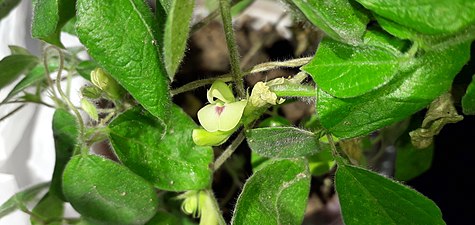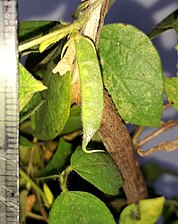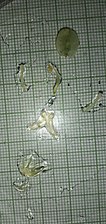Macrotyloma uniflorum
| Macrotyloma uniflorum | |
|---|---|

| |
| Horse gram seeds | |
| Scientific classification | |
| Kingdom: | Plantae |
| Clade: | Tracheophytes |
| Clade: | Angiosperms |
| Clade: | Eudicots |
| Clade: | Rosids |
| Order: | Fabales |
| Family: | Fabaceae |
| Subfamily: | Faboideae |
| Genus: | Macrotyloma |
| Species: | M. uniflorum
|
| Binomial name | |
| Macrotyloma uniflorum | |
| Varieties | |
| |
| Synonyms[1] | |
| |
Macrotyloma uniflorum (horsegram, also known as horse gram, kulthi bean, gahat, hurali, or Madras gram[2]) is a legume native to tropical southern Asia, known for its distinct taste and texture, widely used legume in many cuisines. It is also known for human consumption for its rich nutrients and medicinal properties. It is commonly grown for horse feed, hence the name “horse gram”. Horse gram grown in parts of India, as well as Nepal, Malaysia, Sri Lanka, and is introduced to the West Indies.[3] It is consumed whole, sprouted, or ground. It is consumed in many parts of India and is also known as a superfood, as many Hindus use them to gain nutrients that is not normally found in their sattvic (vegetarian) diet. Horse gram is also allowed to be eaten on some Hindu fasting days. Medical uses of these legumes have been discussed and is described in the Ayurveda.
Description
Macrotyloma uniflorum is a perennial climbing plant with a rhizome, growing to a height of about 60 cm (24 in). The stem sprouts from the rhizome each year. It is clad in varying amounts of whitish hairs and bears alternate, trifoliate leaves with petioles up to 7 cm (2.8 in) long. The leaflets are obovate or elliptical, and up to 7 cm (2.8 in) long. The flowers are borne in twos or threes in the leaf axils, and are typical of the bean family with banner, wings and keel. They are cream, yellowish or green, often with a purple blotch inside. These are followed by linear-oblong, upcurving pods up to 8 cm (3.1 in) long, containing up to ten reddish-brown, speckled or black seeds.[4]
-
Young plant
-
Flowers
-
Young fruit
-
Dissection of floral parts
Distribution
Horse gram is native to tropical southern Asia and has been found in archaeological sites in India, starting from 2500 BC.[5] It was probably first domesticated in India, and is now grown as a legume from India to Myanmar. It is also grown for fodder and as a green manure crop in tropical countries in southeastern Asia, and in northern Australia.[4]
Horse gram thrives where the temperature is in the range 20 to 30 °C (68 to 86 °F) but is killed by frost. It is a drought tolerant crop and is mostly grown in areas with under 900 mm (35 in) of precipitation, and even as little as 380 mm (15 in). In wetter areas, it is usually sown at the end of the wet season, to grow and crop in the dry season.[4]
Nutrition
Horse gram and moth bean are legumes of the tropics and subtropics, grown mostly under dry-land agriculture. The chemical composition is comparable with more commonly cultivated legumes. Like other legumes, these are deficient in methionine and tryptophan, though horse gram is an excellent source of iron and molybdenum. Comparatively, horse gram seeds have higher trypsin inhibitor and hemagglutinin activities and natural phenols than most bean seeds. Natural phenols are mostly phenolic acids, namely, 3,4-dihydroxybenzoic, 4-hydroxybenzoic, vanillic, caffeic, p-coumaric, ferulic, syringic and sinapic acids. Though both require prolonged cooking, a soak solution (1.5% NaHCO3 + 0.5% Na
2CO
3 + 0.75% citric acid) has been shown to reduce cooking time and improve protein quality. Moth bean is mostly consumed as dhal or sprouts.[citation needed]
Horse gram seed contains carbohydrate (57.2% w/w), protein (22% w/w), dietary fiber (5.3% w/w), fat (0.50% w/w), calcium (287 mg), phosphorus (311 mg), iron (6.77 mg) and calories (321 kcal) as well as vitamins like thiamine (0.4 mg), riboflavin (0.2 mg) and niacin (1.5 mg) per 100 grams of dry matter. Its nutritional content is partly dependent on soil conditions and the weather. Its less appealing taste has led it to be not commonly eaten.[6]
Indian regional specifics
In India, it is also known as ulavalu, gahat, muthira, kulath, or kulthi. It is used to make popular dishes like Kulitan Saaru, Kulitan Upkari, Kulitan Ghassi (coconut curry preparation), and an idli-like preparation (but not fermented) called Kulitan Sannan.
- In Telangana and Andhra Pradesh, horse gram is prescribed for jaundice or as a diuretic, and as part of a weight-loss diet.[citation needed] It is considered helpful for iron deficiencies. Ulavacharu (horse gram soup) is popular dish in Telangana, Andhra Pradesh, it is served with cooked rice in some of the Telugu-speaking people's weddings and ceremonies.
- In Darjeeling and Sikkim, horse gram (called (gahat in Nepali) is considered a medicinal food. It is given to children suffering from mumps. Water in which gahat is soaked is taken by people suffering from kidney stones in the belief that this dissolves the crystals. Gahat's use is specially reserved for the cold winters, when its heat-producing properties are most useful.
- In Kerala, horse gram, (called മുതിര (muthira) in Malayalam which almost sounds like കുതിര (kuthira), Malayalam word for horse), is used in special kinds of dishes.
- In Tamil Nadu, horse gram (called கொள்ளு - 'kollu' in northern districts and காணம் - 'kaanam' in southern districts ) is commonly used in Tamil dishes, including kollu chutney, kollu porial, kollu avial, kollu sambar, and kollu rasam.
- In Maharashtra and Goa, horse gram (called हुलगा) (hulage/hulaga/kulith in Marathi and kulith in Konkani) is often used to make aamati, kulith usal, pithla and shengule/shevanti.
- In Karnataka cuisine, ಹುರಳಿಸಾರು (hurali saaru), ಹುರಳಿ (hurali) is a main ingredient. Hurali is also used in preparations such as usali, chutney, bassaru, and upsaaru or upinsaru (particularly in the Old Mysore Regions Mandya and Chamrajnagara Districts).
- In South Canara region of Karnataka, in Tulu, it is also called kudu (ಕುಡು).
- In Odisha it is known by the name କୋଳଥ (Kolatha).
- Gahat or kulath is a major ingredient in the food of Pahari region of northern India.
- In Himachal Pradesh, kulath is used to make khichdi. In Uttarakhand, it is cooked in a round iron saute pan (kadhai) to prepare ras, a favorite of most Kumaonis. In Garhwal region, another more elaborate dish is phanu which is made in a kadhai with roughly ground gahat (previously soaked overnight) boiled over several hours. Towards the end, some finely chopped greens (palak or spinach, rai, tender radish leaves, or dhania (coriander leaves) if nothing else is available) are added to complete the dish. Served with boiled rice, jhangora (a millet-like grain, used as a staple by poorer Garhwalis only a decade ago and now a prized health-food)
In Myanmar (Burma), horse gram is known as pe bazat (‹See Tfd›ပဲပိစပ်) in Burmese. It is commonly used in making pon ye gyi, a fermented bean paste used in traditional Burmese cuisine.
Medicinal uses
Scientists from the Indian Institute of Chemical Technology have found that unprocessed raw horse gram seeds not only possess antihyperglycemic properties[citation needed], but also have qualities which reduce insulin resistance. The scientists made[citation needed] a comparative analysis between horse gram seeds and their sprouts and found that the seeds have greater beneficial effects on the health of hyperglycemic individuals. The majority of antioxidant properties are confined to the seed coat and its removal would not do any good[citation needed]. Raw horse gram seed is rich in polyphenols, flavonoids, and proteins, major antioxidants present in fruits and other food materials. The seed has the ability to reduce postprandial hyperglycemia by slowing down carbohydrate digestion and reducing insulin resistance by inhibiting protein-tyrosine phosphatase 1 beta enzyme.[7][citation needed]
References
- ^ "Macrotyloma uniflorum (Lam.) Verdc". Plants of the World Online. Board of Trustees of the Royal Botanic Gardens, Kew. 2017. Retrieved 17 July 2020.
- ^ "Taxonomy - GRIN-Global Web v 1.10.5.0". npgsweb.ars-grin.gov. Retrieved 24 September 2019.
- ^ "Horse Gram" (PDF). Government of India, Directorate of Pulses Development. 3 April 2017.
- ^ a b c Brink, Martin (2006). Cereals and Pulses. PROTA. pp. 102–104. ISBN 978-90-5782-170-7.
- ^ Pearman, Georgina (2005). Prance, Ghillean; Nesbitt, Mark (eds.). The Cultural History of Plants. Routledge. p. 144. ISBN 0415927463.
- ^ Bhartiya, A.; Aditya, J. P.; Kant, L. (2015). "NUTRITIONAL AND REMEDIAL POTENTIAL OF AN UNDERUTILIZED FOOD LEGUME HORSEGRAM (Macrotyloma uniflorum): A REVIEW". The Journal of Animal & Plant Sciences. 25 (4): 908–920. ISSN 1018-7081.
- ^ Mallikarjun, Y. (April 25, 2013). "Raw horse gram good for diabetics". The Hindu. Retrieved May 31, 2017.
External links
- Fuller, D.Q. & Murphy, C. (2018). "The origins and early dispersal of horsegram (Macrotyloma uniflorum), a major crop of ancient India". Genetic Resources and Crop Evolution. 65: 285–305. doi:10.1007/s10722-017-0532-2. S2CID 9543710.
{{cite journal}}: CS1 maint: multiple names: authors list (link)
- Kadam SS, Salunkhe DK (1985). "Nutritional composition, processing, and utilization of horse gram and moth bean". Crit Rev Food Sci Nutr. 22 (1): 1–26. doi:10.1080/10408398509527416. PMID 3899515.




